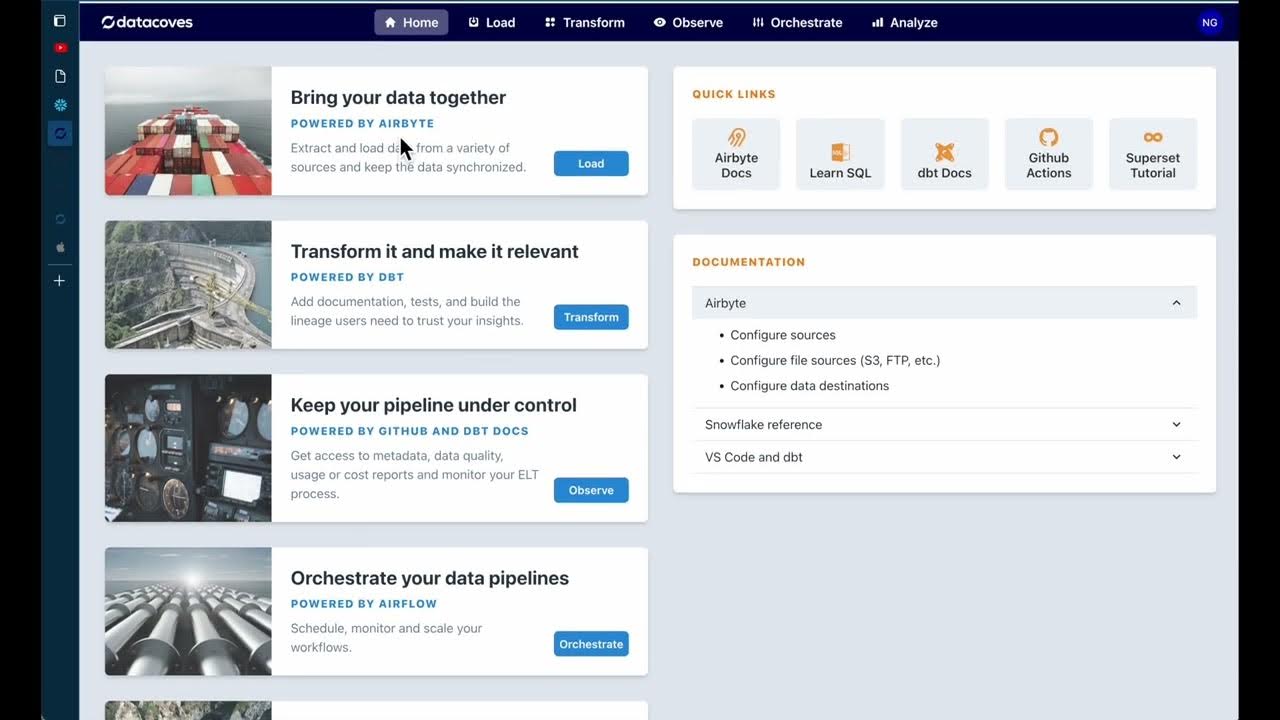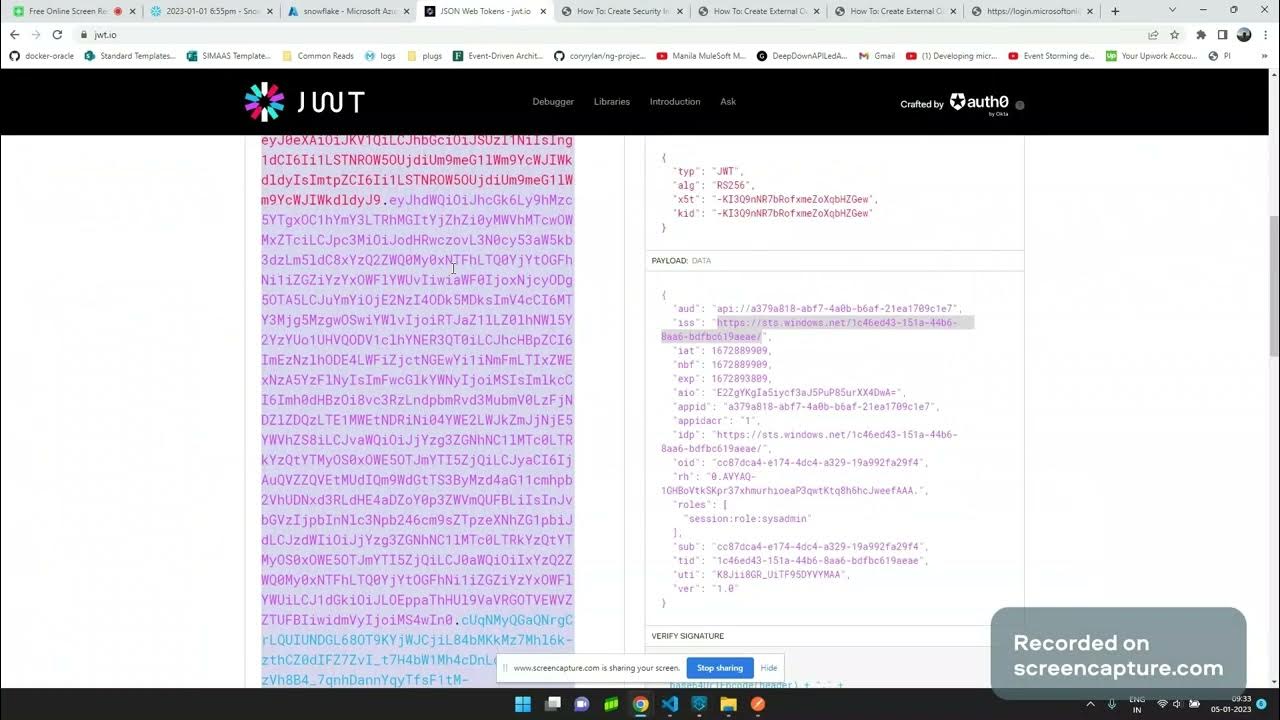Creating your first project in data build tool (dbt) | Tutorial for beginners
Summary
TLDRThis video tutorial guides viewers through the process of building and managing DBT models in Snowflake. It covers creating SQL models, materializing them as tables or views, and organizing them into modular components for better scalability. The script also demonstrates how to use DBT’s `ref` function to establish dependencies between models and how to generate interactive documentation to visualize model relationships. By modularizing the code into staging models and transformation models, users can improve code reusability and maintain a more flexible data pipeline, making it suitable for enterprise-level projects.
Takeaways
- 😀 Models in dbt are SQL scripts that transform data into a format suitable for reporting or analytics.
- 😀 dbt models live in the 'models' directory of your project and correspond to tables or views in the data warehouse.
- 😀 dbt automatically handles the creation of tables and views based on the SQL code you write in your models.
- 😀 You can materialize dbt models as either views or tables, and this can be configured in the model's `.sql` file.
- 😀 The `ref()` function in dbt allows you to reference other models, creating dependencies that dbt will manage for you.
- 😀 Running `dbt run` compiles and executes your models, ensuring that they are executed in the correct order based on dependencies.
- 😀 dbt automatically cleans up models by deleting previous views or tables when you modify a model and rerun it.
- 😀 Modularity in dbt allows you to break down large transformations into smaller, reusable components, improving code organization and reuse.
- 😀 By splitting the transformation logic into staging models (e.g., stage_orders, stage_customers), you promote flexibility and reusability across different projects.
- 😀 The `dbt docs generate` command creates interactive project documentation, including model dependencies and lineage graphs, to track relationships between models.
- 😀 dbt’s Directed Acyclic Graph (DAG) manages model dependencies automatically, ensuring that models run in the correct order without manual intervention.
Q & A
What are models in dbt, and how do they work?
-Models in dbt are SQL files that help shape data into a format suitable for reporting or analytics. Each model corresponds to a table or view in the data warehouse. dbt handles the underlying DDL or DML operations, such as creating tables or views, based on the SQL code provided in the model.
How does dbt handle the execution of models?
-When a model is executed, dbt automatically determines the dependencies between models and runs them in the correct order. This ensures that all necessary transformations are applied before the target model is built.
What is the purpose of the ref function in dbt?
-The ref function in dbt is used to reference other models within your project. It creates dependencies between models and allows dbt to track and manage these relationships. It ensures that any changes made to a referenced model are reflected in models that depend on it.
What is the difference between a view and a table in dbt, and how can you choose between them?
-A view in dbt is a virtual table that doesn’t store data but instead pulls it dynamically from other sources. A table, on the other hand, is a materialized structure that stores data physically. To change a model from a view to a table, you can use a configuration block in the model SQL file to specify the desired materialization.
How does dbt help with modularizing a data project?
-dbt promotes modularity by breaking down large SQL scripts into smaller, reusable models. This approach helps in creating more flexible and maintainable data pipelines. For example, you can split up a large transformation into staging models, which can then be used across multiple final models, promoting reusability.
What is the purpose of staging tables in dbt, and how do they fit into the overall model structure?
-Staging tables in dbt are intermediate models that are used to clean, transform, and prepare raw data before it’s used in final models. By modularizing transformations into staging models, dbt makes it easier to maintain and update specific parts of the pipeline without affecting the entire project.
How does dbt track dependencies between models?
-dbt uses the ref function to track dependencies between models. When one model depends on another, dbt ensures that the dependent models are executed first, maintaining the correct order of transformations and data flow.
What is the benefit of dbt's automatic handling of dependencies when running models?
-The automatic handling of dependencies allows dbt to determine the correct execution order for models, ensuring that changes in one model do not cause errors in others. This removes the manual burden of tracking and managing execution order, especially in complex projects.
How does dbt allow for flexible and reusable models?
-dbt's modular structure allows for reusable models by separating transformations into smaller, independent units (such as staging models). These models can then be referenced by other models using the ref function. If logic changes in one staging model, it automatically propagates through dependent models.
How does dbt help with documentation and lineage tracking?
-dbt can automatically generate documentation for your project, providing details on models, their columns, and dependencies. It also includes a lineage graph, which visually represents the relationships between models, helping users understand how data flows through the entire project.
Outlines

This section is available to paid users only. Please upgrade to access this part.
Upgrade NowMindmap

This section is available to paid users only. Please upgrade to access this part.
Upgrade NowKeywords

This section is available to paid users only. Please upgrade to access this part.
Upgrade NowHighlights

This section is available to paid users only. Please upgrade to access this part.
Upgrade NowTranscripts

This section is available to paid users only. Please upgrade to access this part.
Upgrade NowBrowse More Related Video

Code along - build an ELT Pipeline in 1 Hour (dbt, Snowflake, Airflow)

How to Create an ELT Pipeline Using Airflow, Snowflake, and dbt!

dbt model Automation compared to WH Automation framework

Snowflake connector for MuleSoft using Azure Oauth Client Credentials

Snowsql Setup | How to login to snowsql | snowsql CLI

An overview of AutoGen Studio 2.0 in under 10 minutes!
5.0 / 5 (0 votes)